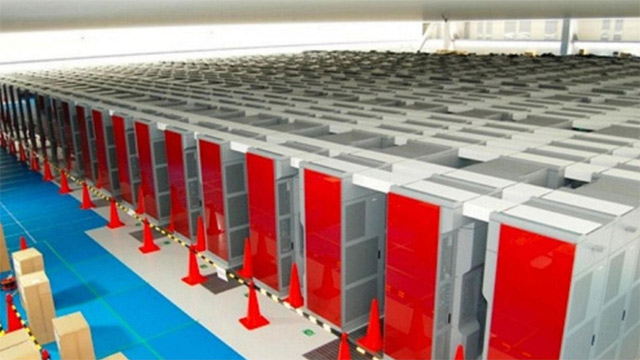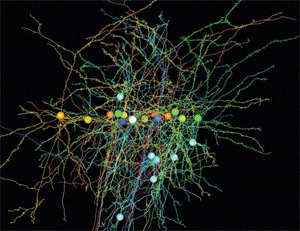Simulation of the 1st second of activity of 1% of the brain took 40 minutes on a cluster of 82,944 processors
A group of German and Japanese researchers carried out an approximate computer simulation of the brain activity of the human brain neuron network on a scale of 1% of the brain's neural network for 1 second. Today it is the largest experiment in the simulation of brain activity.
One percent of the brain is 1.73 billion nerve cells and 10.4 trillion synapses connecting them. To conduct the experiment, scientists involved 82 944 processors of the K supercomputer and 1 petabyte of memory (24 bytes per synapse).

Supercomputer K
The experiment was made possible by NEST software with “advanced innovative data structures,” according to a press release from the Institute of Physical and Chemical Research of Japan (RIKEN). This free software is available to researchers from around the world, so that everyone can repeat the experiment on their own computer cluster with a sufficient amount of RAM.
')
 A second of neural activity on the supercomputer K with a capacity of 10.5 petaflops (the fourth most powerful supercomputer in the Top-500 list) was calculated for 40 minutes. Nerve cells connected randomly to each other. The experiment did not aim to find out some new knowledge about the work of the human brain, but only to check the limitations of its computer simulation technology. In the future, the software will be improved, and then it will be possible to put more meaningful experiments.
A second of neural activity on the supercomputer K with a capacity of 10.5 petaflops (the fourth most powerful supercomputer in the Top-500 list) was calculated for 40 minutes. Nerve cells connected randomly to each other. The experiment did not aim to find out some new knowledge about the work of the human brain, but only to check the limitations of its computer simulation technology. In the future, the software will be improved, and then it will be possible to put more meaningful experiments.
In addition, scientists now have an idea of what roughly computer capacities are required to simulate 100% of the human brain in real time. Perhaps this will be possible in 10-20 years. If you do not put a real-time limit, then simulation of 100% of the brain in the "slow" mode is possible already on next-generation supercomputers with a memory capacity of 100 petabytes and a performance of more than 1 exaflops.
One percent of the brain is 1.73 billion nerve cells and 10.4 trillion synapses connecting them. To conduct the experiment, scientists involved 82 944 processors of the K supercomputer and 1 petabyte of memory (24 bytes per synapse).

Supercomputer K
The experiment was made possible by NEST software with “advanced innovative data structures,” according to a press release from the Institute of Physical and Chemical Research of Japan (RIKEN). This free software is available to researchers from around the world, so that everyone can repeat the experiment on their own computer cluster with a sufficient amount of RAM.
')
 A second of neural activity on the supercomputer K with a capacity of 10.5 petaflops (the fourth most powerful supercomputer in the Top-500 list) was calculated for 40 minutes. Nerve cells connected randomly to each other. The experiment did not aim to find out some new knowledge about the work of the human brain, but only to check the limitations of its computer simulation technology. In the future, the software will be improved, and then it will be possible to put more meaningful experiments.
A second of neural activity on the supercomputer K with a capacity of 10.5 petaflops (the fourth most powerful supercomputer in the Top-500 list) was calculated for 40 minutes. Nerve cells connected randomly to each other. The experiment did not aim to find out some new knowledge about the work of the human brain, but only to check the limitations of its computer simulation technology. In the future, the software will be improved, and then it will be possible to put more meaningful experiments.In addition, scientists now have an idea of what roughly computer capacities are required to simulate 100% of the human brain in real time. Perhaps this will be possible in 10-20 years. If you do not put a real-time limit, then simulation of 100% of the brain in the "slow" mode is possible already on next-generation supercomputers with a memory capacity of 100 petabytes and a performance of more than 1 exaflops.
Source: https://habr.com/ru/post/189004/
All Articles